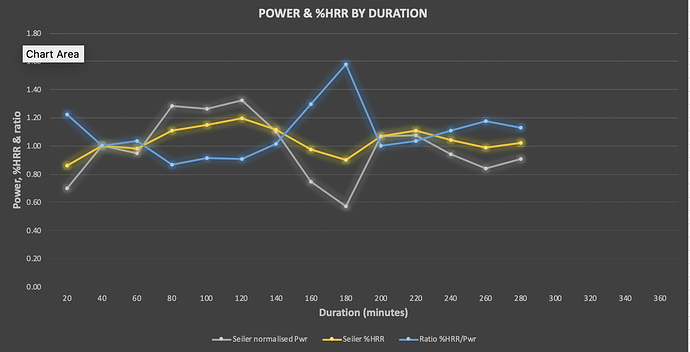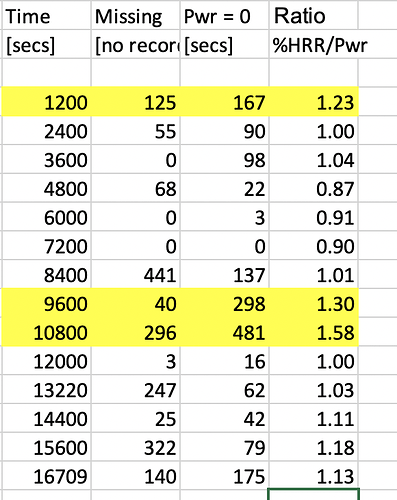Ok, so here is a recent ride. I’m going to use it to indicate a couple of issues that I have encountered using the Seiler method. The graph is computed using Seiler’s methods, as outlined in video that David posted 6 days ago:
.
The blue line represents the HR/Pwr curve for 20 minute intervals. Note how it is high at the beginning of the ride and again in the middle. That apparently indicates decoupling [HR high relative to Pwr]. How can this be? It’s not that the Pwr was especially high during those periods.
I downloaded the ride csv file [thank you David!]. And here is what I found, again for the 20-minute intervals:
On this table, the columns are, from left to right: the time at the end of the intervals in seconds; the number of seconds for which there was no record [headunit not recording] during that interval; the number of seconds for which Pwr = 0 in that interval; and Seilers HR/Pwr ratio [the blue line in the chart].
At the beginning of the ride there are 2:05 mins with headunit not recording and 2:47 mins with Pwr = 0. This is a period of start - stop riding - coasting up to stop signs, coasting up to red lights, stopping and then starting again. You stop pedalling and when you stop motion the headunit turns off after a few seconds. Between the time when you stop pedalling and the headunit turns off, Pwr = 0, but HR is still being recorded. So HR/Pwr is high: you are apparently decoupled.
After 45 minutes or so [2700 secs], the ride settled into a mountain climb, which took until 2:10 hrs [7800 secs], when power was steady and the decoupling index stabilised at about 0.9.
At the top of the mountain, took a break, descended the mountain with periods of coasting, took some more breaks. This phase last until nearly 3:00 hrs into the ride [~10500 secs]. Notice the periods of no record from the headunit [= breaks] and of zero power [= coasting]. Again, while there is zero power but movement, the unit is still recording HR. Again, apparent decoupling.
The a steady ride home, except for a break at about 4:15 hrs [~15300 secs], which again shows up as decoupling.
So: beware, oh take care! Stops, coasting and the like make more complex the interpretation of graphs of decoupling.
Another phenomenon which affects the apparent level of decoupling is changes in cadence. Seiler notes this. And I can confirm his observations.
All that said, what does this graph indicate? At 200 minutes, the blue line [Seiler’s index] is at the same level as it was at 140 minutes [though both observations are affected by stops]. After that, though, there is some evidence of real decoupling: the blue line begins to rise steadily.
Sorry for the long post. I hope that this helps everyone interpret these data.



 This is just my thing: go long, go hard and I can extend it alright, but closing in on 4 hours, there’s a little more decoupling going on.
This is just my thing: go long, go hard and I can extend it alright, but closing in on 4 hours, there’s a little more decoupling going on.







